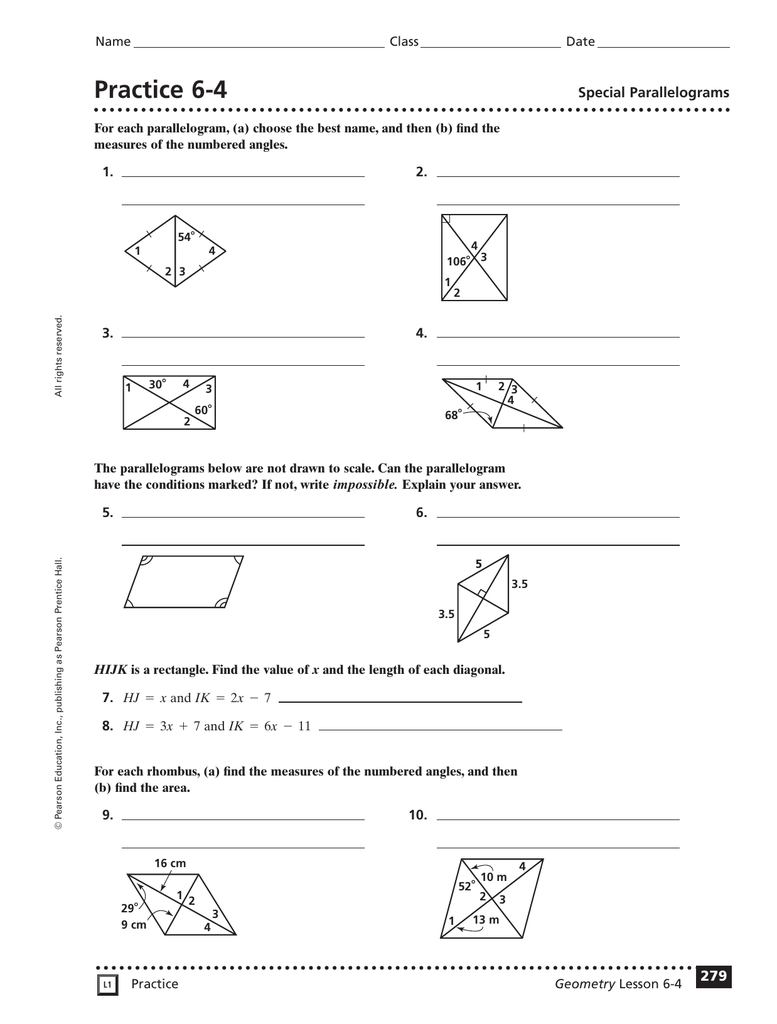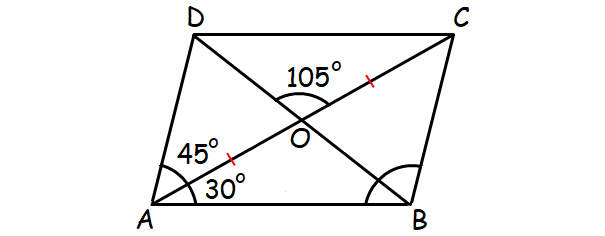Imagine yourself standing in a lush garden, surrounded by vibrant blooms. As you gaze up at a stunning butterfly, its wings seem to dance in the gentle breeze. Have you ever noticed how the butterfly’s wings, even though they move, always seem to maintain a certain shape? This shape might remind you of a special kind of quadrilateral called a parallelogram—a shape whose opposite sides are parallel. Just as the butterfly’s wings possess unique characteristics, parallelograms also hold a world of interesting properties waiting to be discovered. This article will be your guide to unlocking those secrets, providing a comprehensive study guide and intervention tests to master the world of parallelograms.

Image: laberisbel.github.io
Parallelograms, with their fascinating properties, are a fundamental concept in geometry, influencing fields spanning architecture to engineering. From the intricate grid patterns of a windowpane to the sturdy structure of a bridge, parallelograms play a crucial role in our world. Understanding parallelograms is not just about textbook knowledge; it’s about gaining a deeper appreciation for the geometry that surrounds us. This article will equip you with the knowledge and practice you need to confidently navigate the world of parallelograms.
Exploring the World of Parallelograms: A Deep Dive
Let’s begin our journey into the world of parallelograms by defining this intriguing geometric shape. A parallelogram is a quadrilateral, a polygon with four sides, where both pairs of opposite sides are parallel. This simple definition paves the way for a cascade of captivating properties.
Fundamental Properties of Parallelograms
- Opposite sides are congruent: The two sides facing each other in a parallelogram are equal in length. This creates a sense of balance and symmetry within the shape.
- Opposite angles are congruent: Just like the sides, the angles opposite each other in a parallelogram are also equal. This consistency ensures a predictable pattern within the shape.
- Consecutive angles are supplementary: Consecutive angles, those sharing a side, add up to 180 degrees. This interplay between angles ensures the shape remains stable and well-defined.
- Diagonals bisect each other: When you draw lines connecting opposite corners, creating diagonals, these lines intersect in the exact middle point of both. This central point acts like the heart of the parallelogram, maintaining its geometric equilibrium.
Types of Parallelograms
Within the parallelogram family, there are specialized members with unique properties:
- Rectangles: A rectangle is a parallelogram where all four interior angles measure 90 degrees. Think of the perfectly square corners of a door frame or a window.
- Rhombuses: A rhombus is a parallelogram where all four sides are congruent. Picture a diamond shape, with its four sides equal in length.
- Squares: A square is a special type of parallelogram that combines the features of a rectangle and a rhombus. All interior angles are 90 degrees, and all four sides are congruent. It’s the epitome of geometric perfection, symbolizing stability and uniformity.

Image: www.onlinemath4all.com
Applications of Parallelograms
Beyond their geometric elegance, parallelograms hold a significant place in various fields, their properties lending themselves to practical applications:
- Architecture: Parallelograms are the foundation of many architectural designs. From the rectangles that define rooms to the rhombus-shaped patterns in stained glass windows, parallelograms add both structure and aesthetic appeal to buildings.
- Engineering: Engineering relies heavily on the properties of parallelograms for stability. Bridges, trusses, and other structures utilize the strength and predictable behavior of parallelograms to withstand stress and distribute force effectively.
- Art and Design: Artists and designers often use parallelograms to create visual interest and dynamic compositions. The repetition and geometric patterns created by parallelograms can evoke a sense of order, harmony, and balance in art.
Mastering the Concepts: A Study Guide Companion
Now that you have a strong foundation in the properties and types of parallelograms, it’s time to solidify your understanding with a guided study approach:
- Visual Representation: Draw multiple examples of parallelograms, rectangles, rhombuses, and squares. Label their sides, angles, and diagonals to reinforce the key properties.
- Problem-Solving Practice: Engage in practice problems that focus on proving geometric properties, finding missing lengths, or calculating angles.
- Real-World Applications: Look for examples of parallelograms in your surroundings, and identify the specific properties at play. This will create a deeper connection between theoretical concepts and practical applications.
Conquering the Challenges: Intervention Tests for Success
To ensure you’ve mastered the concepts, it’s essential to assess your understanding through intervention tests. These tests focus on identifying areas where you might need additional practice or clarification:
- Multiple-Choice Questions: These test your ability to recall basic definitions, identify properties, and solve problems using given information.
- True or False Questions: These questions test your grasp of fundamental concepts and challenge you to analyze statements about parallelograms.
- Short-Answer Questions: These questions require you to explain concepts in your own words, demonstrating your understanding of the relationships between properties.
- Proof-Based Problems: These problems challenge you to logically and systematically prove geometric claims using established theorems and definitions.
Expert Insights for Parallelogram Mastery
As you progress on your parallelogram journey, seeking insights from experienced mathematicians can provide valuable guidance:
- Break Down Complex Problems: When tackling a difficult problem, break it down into smaller, manageable steps. This allows you to focus on specific properties and approach the problem with a clear strategy.
- Visualize Solutions: Use sketching and diagrams as a powerful tool to understand concepts and develop solutions. Visualizing a problem can reveal patterns and relationships that might not be immediately apparent.
- Engage with Others: Collaborate with classmates, peers, or mentors to discuss problems and share perspectives. This can spark new ideas and deepen your understanding of the concepts.
6-3 Study Guide And Intervention Tests For Parallelograms
Conclusion: Embracing the Power of Parallelograms
As you’ve delved into the intriguing world of parallelograms, you’ve not only gained a deeper understanding of this geometric shape, but you’ve also discovered its profound influence on our world. Parallelograms are not just abstract concepts; they are the building blocks of architecture, engineering, and art. By embracing their properties and mastering the concepts we’ve explored, you become equipped to navigate a world brimming with geometric wonder. Keep exploring, keep learning, and let the power of parallelograms guide you on your journey of discovery!






